Only on a fixed-forward mounting! At least on the Fairmile, firing abeam would risk capsizing the thing.You are correct, but it would fit on an small warship like an Fairmile D motor gun boat or the Steam Gun Boat
Last edited:
Only on a fixed-forward mounting! At least on the Fairmile, firing abeam would risk capsizing the thing.You are correct, but it would fit on an small warship like an Fairmile D motor gun boat or the Steam Gun Boat
I get the impression from reading various memoirs that the official armament of coastal motor forces was whatever the bosun or the jimmy could blag.You are correct, but it would fit on an small warship like an Fairmile D motor gun boat or the Steam Gun Boat
Aussie Engineer: wait, actually give it back and get me another. I'm gonna need a few for this one.Aussie Engineer: Hold my beer.....
I seem to remember it spending some time as a gate guard at Duxford.
Britain's Monstrous Green Mace AA Gun -
Today's subject is going to cover the Green Mace anti-aircraft gun, a rather odd project, one that had a lot of potential, but found itself intankhistoria.com
Thanks so it was a Grand Slam and not a Tall boy... around 4 metric tons of torpex... There is a TL waiting thereThe Grand Slam was at Scampton. Had it gone off, it would have levelled Lincoln Cathedral several miles away.
They built a belt fed 3.7" AA gun postwar - I've got a photo and some drawings somewhere.
The Grand Slam was at Scampton. Had it gone off, it would have levelled Lincoln Cathedral several miles away.
Just for lols I put it into a nuke effects simulator:Lincoln Cathedral is 5 miles away, Little Boy or Fat Man going off wouldn't level the Cathedral, a Grand Slam definitely wouldn't, they are big bombs but not super weapons.

Wouldn't put it past the fly boys - do like their toys.Just for lols I put it into a nuke effects simulator:

NUKEMAP by Alex Wellerstein
NUKEMAP is a website for visualizing the effects of nuclear detonations.nuclearsecrecy.com
You’d need a multi megaton class nuke to be the gate guard to level the cathedral.
Just for lols I put it into a nuke effects simulator:

NUKEMAP by Alex Wellerstein
NUKEMAP is a website for visualizing the effects of nuclear detonations.nuclearsecrecy.com
You’d need a multi megaton class nuke to be the gate guard to level the cathedral.
Wouldn't put it past the fly boys - do like their toys.

ITTL Singapore has so far been untouched and I think the window where the IJN could have launched a damaging attack to the harbour/ base has mostly passed with the significant reinforcements that have been sent. It really doesn't need anything further. It's a really interesting project. We all know how starved for funding British forces were in the 20s and 30s. Yet the expenditure on Singapore base was huge. Sixty Million pounds. That's back when a million pounds was a lot of money not just a crappy 2 bed flat in south london. Now while construcion was approved in 1923t, not much was done until Japan invaded Manchuria and that 60 Million quid was mostly spent between 1932 and 1938...but keep in mind the entire British defence budget in 1932 - everything, equipment, wages, boot polish, spam was 102 M pounds. We scoff at the French for their foolishness at the Maginot line... yet singapore was handed over like a gift wrapped present.Indeed....
P/s: I think I accidently deleted the second part of my question which was...
before posting...
The unusually high rate of fire , or rather high rate of shells landing on German things, was due to the consistency of the weight of the seperate power charges, the Mark 2 carriage, a focus on calibrated range rather than firing angle. The 25lb was a pragmatic (ahem ..cheap reuse intially and not with new guns until '38) extension of the Great War 18lbr and was big for a field gun but small for a Howitzer.The question wasn't rate of fire, it was sustained rate of fire. There is an legend of the Nazis believing the Thomies having belt feeded hows. The fact that the individual British Royal Artillery Regiment had 24 guns (instead of 18 or even 12 in German Artillery Batallions) was also a factor
 ww2talk.com
ww2talk.com
I think there has been a step missed or the copying went astray. The Fd Regt of 24 guns was at Bde level. The Division had three Regts of 24 guns each so 72 guns. If you look at the corps level listed above, you see nine fd regts, Assuming three Divs per Corps, that would be correct. So I suspect the Mike tgt was the Bde level, ie the whole Regt of 24 guns, and the Uncle Tgt was a divisional level of 72 guns.It is worth remembering that the British Royal Artillery also had fine tuned the capability of every gun in range to fire at a target if needed. By D-day the Royal Artillery was firing using codes that denoted how many tubes fired on a target. The rate of fire was pretty good and the sheer number of tubes able to fire on a target was insane.

What is an 'UNCLE' in Artillery terms?
Can anyone tell me what an 'UNCLE' is with regard to Artillery? Context is as follows from the 2/4 KOYLI war diaries during operations at Salerno....ww2talk.com
Royal Artillery Methods in World War 2
The field artillery tactics and gunnery used by the Royal Artillery and the artilleries of Britishnigelef.tripod.com
From the 2 links above the weight of fire is as below.
Mike – eight 25 pounders of the field battery
Uncle -24 guns of the field regiment (division level)
Victor - 216 guns of nine field regiments (corp. level)
Williams - 216 guns of nine field regiments, 2 regiments of 16 medium guns 4.5 inch and 2 regiments of 16 heavy guns 7.2 inch and any other attached artillery regiment in the army.
Now the above is directly copied from user Clankypencil and is likely correct. However I once read of a "yoke" target call that was supposed to take every single artillery piece in range and have it fire on the grid co-ordinates with serious consequences. German units wanted to know about the automatic 25lb guns. Inside the links was talk of individual gun crews achieving 17 rds in a minute which is insane considering seperate bag and shell.
The full links and the name of the user on another forum who researched the data is included out of respect for the effort made to make the details available for me and others to find.